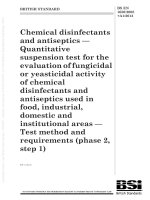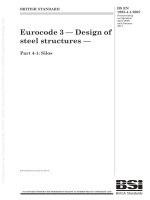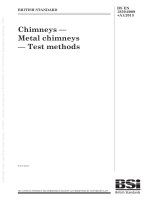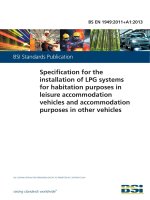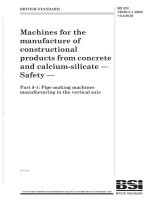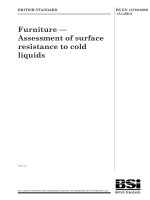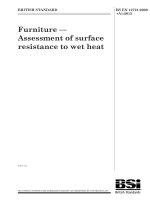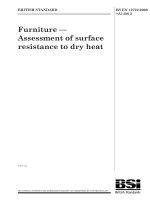Bsi bs en 62325 451 1 2013
Bạn đang xem bản rút gọn của tài liệu. Xem và tải ngay bản đầy đủ của tài liệu tại đây (1.44 MB, 44 trang )
BS EN 62325-451-1:2013
BSI Standards Publication
Framework for energy market
communications
Part 451-1: Acknowledgement business
process and contextual model for CIM
European market
BRITISH STANDARD
BS EN 62325-451-1:2013
National foreword
This British Standard is the UK implementation of EN 62325-451-1:2013. It
is identical to IEC 62325-451-1:2013.
The UK participation in its preparation was entrusted to Technical
Committee PEL/57, Power systems management and associated
information exchange.
A list of organizations represented on this committee can be obtained on
request to its secretary.
This publication does not purport to include all the necessary provisions of
a contract. Users are responsible for its correct application.
© The British Standards Institution 2014.
Published by BSI Standards Limited 2014
ISBN 978 0 580 71519 8
ICS 33.200
Compliance with a British Standard cannot confer immunity from
legal obligations.
This British Standard was published under the authority of the
Standards Policy and Strategy Committee on 28 February 2014.
Amendments/corrigenda issued since publication
Date
Text affected
BS EN 62325-451-1:2013
EN 62325-451-1
EUROPEAN STANDARD
NORME EUROPÉENNE
EUROPÄISCHE NORM
December 2013
ICS 33.200
English version
Framework for energy market communications Part 451-1: Acknowledgement business process and contextual model for
CIM European market
(IEC 62325-451-1:2013)
Cadre pour les communications pour le
marché de l'énergie Partie 451-1: Processus métier d'accusé
de réception et modèle contextuel pour le
marché européen CIM
(CEI 62325-451-1:2013)
Kommunikation im Energiemarkt Teil 451-1: Geschäftsprozessnachweis
und kontextbezogenes CIM-Modell für den
europäischen Markt
(IEC 62325-451-1:2013)
This European Standard was approved by CENELEC on 2013-11-11. CENELEC members are bound to comply
with the CEN/CENELEC Internal Regulations which stipulate the conditions for giving this European Standard
the status of a national standard without any alteration.
Up-to-date lists and bibliographical references concerning such national standards may be obtained on
application to the CEN-CENELEC Management Centre or to any CENELEC member.
This European Standard exists in three official versions (English, French, German). A version in any other
language made by translation under the responsibility of a CENELEC member into its own language and notified
to the CEN-CENELEC Management Centre has the same status as the official versions.
CENELEC members are the national electrotechnical committees of Austria, Belgium, Bulgaria, Croatia, Cyprus,
the Czech Republic, Denmark, Estonia, Finland, Former Yugoslav Republic of Macedonia, France, Germany,
Greece, Hungary, Iceland, Ireland, Italy, Latvia, Lithuania, Luxembourg, Malta, the Netherlands, Norway, Poland,
Portugal, Romania, Slovakia, Slovenia, Spain, Sweden, Switzerland, Turkey and the United Kingdom.
CENELEC
European Committee for Electrotechnical Standardization
Comité Européen de Normalisation Electrotechnique
Europäisches Komitee für Elektrotechnische Normung
CEN-CENELEC Management Centre: Avenue Marnix 17, B - 1000 Brussels
© 2013 CENELEC -
All rights of exploitation in any form and by any means reserved worldwide for CENELEC members.
Ref. No. EN 62325-451-1:2013 E
BS EN 62325-451-1:2013
EN 62325-451-1:2013
-2-
Foreword
The text of document 57/1381/FDIS, future edition 1 of IEC 62325-451-1, prepared by IEC/TC 57,
"Power systems management and associated information exchange" was submitted to the IECCENELEC parallel vote and approved by CENELEC as EN 62325-451-1:2013.
The following dates are fixed:
•
latest date by which the document has
to be implemented at national level by
publication of an identical national
standard or by endorsement
(dop)
2014-08-11
•
latest date by which the national
standards conflicting with the
document have to be withdrawn
(dow)
2016-11-11
Attention is drawn to the possibility that some of the elements of this document may be the subject of
patent rights. CENELEC [and/or CEN] shall not be held responsible for identifying any or all such
patent rights.
Endorsement notice
The text of the International Standard IEC 62325-451-1:2013 was approved by CENELEC as a
European Standard without any modification.
In the official version, for Bibliography, the following notes have to be added for the standards
indicated:
IEC 62325-301
NOTE
Harmonised as EN 62325-301.
IEC 62325-451 (series) NOTE
Harmonised as EN 62325-451 (series).
ISO 15000-5
Harmonised as EN ISO 15000-5.
NOTE
-3-
BS EN 62325-451-1:2013
EN 62325-451-1:2013
Annex ZA
(normative)
Normative references to international publications
with their corresponding European publications
The following documents, in whole or in part, are normatively referenced in this document and are
indispensable for its application. For dated references, only the edition cited applies. For undated
references, the latest edition of the referenced document (including any amendments) applies.
NOTE When an international publication has been modified by common modifications, indicated by (mod), the relevant EN/HD
applies.
Publication
Year
Title
IEC/TS 61970-2
2004
Energy management system application
program interface (EMS-API) Part 2: Glossary
CLC/TS 61970-2
Framework for energy market
communications Part 351: CIM European market model
exchange profile
FprEN 62325-351
IEC 62325-351
-
IEC 62325-450
2013
IEC 62361-100
-
1)
At draft stage.
EN/HD
Year
2005
1)
Framework for energy market
EN 62325-450
communications Part 450: Profile and context modelling rules
Harmonization of quality codes across TC 57 - FprEN 62361-100
Part 100: Naming and design rules for CIM
profiles to XML schema mapping
-
2013
1)
-
BS EN 62325-451-1:2013
–2–
62325-451-1 IEC:2013
CONTENTS
INTRODUCTION ..................................................................................................................... 7
1
Scope ............................................................................................................................... 8
2
Normative references ....................................................................................................... 8
3
Terms and definitions ....................................................................................................... 8
4
Document contextual model and message assembly model basic concepts .................... 10
5
4.1 Overview ............................................................................................................... 10
4.2 European style market package structure .............................................................. 11
4.3 From the European style market profile to the document contextual model ............ 12
4.4 From the document contextual model to the message assembly model ................. 13
4.5 From the assembly model to the XML schema ....................................................... 14
The acknowledgment business process .......................................................................... 14
5.1
6
Business process definition ................................................................................... 14
5.1.1 General ..................................................................................................... 14
5.1.2 Technical acknowledgment ........................................................................ 15
5.1.3 Application acknowledgment ...................................................................... 15
5.2 Business rules for the acknowledgment document ................................................. 16
5.2.1 General ..................................................................................................... 16
5.2.2 Time .......................................................................................................... 16
5.2.3 Reason ...................................................................................................... 16
Contextual and assembly models ................................................................................... 17
6.1
7
Acknowledgement contextual model ...................................................................... 17
6.1.1 Overview of the model ............................................................................... 17
6.1.2 IsBasedOn relationships from the European style market profile ................ 18
6.1.3 Detailed Acknowledgement contextual model ............................................ 19
6.2 Acknowledgement assembly model ....................................................................... 24
6.2.1 Overview of the model ............................................................................... 24
6.2.2 IsBasedOn relationships from the European style market profile ................ 25
6.2.3 Detailed Acknowledgement assembly model .............................................. 25
6.2.4 Datatypes .................................................................................................. 30
6.2.5 Enumerations ............................................................................................ 33
XML schema .................................................................................................................. 33
7.1
7.2
7.3
XML schema URN Namespace rules ..................................................................... 33
Code list URN namespace rules ............................................................................ 34
URI rules for model documentation ........................................................................ 34
7.3.1 Datatype .................................................................................................... 34
7.3.2 Class ......................................................................................................... 34
7.3.3 Attribute .................................................................................................... 34
7.3.4 Association end role name ......................................................................... 35
7.4 Acknowledgement_MarketDocument schema ........................................................ 35
7.4.1 Schema Structure ...................................................................................... 35
7.4.2 Schema description ................................................................................... 37
Bibliography .......................................................................................................................... 40
BS EN 62325-451-1:2013
62325-451-1 IEC:2013
–3–
Figure 1 – IEC 62325-450 modelling framework .................................................................... 11
Figure 2 – Overview of European style market profile dependency ........................................ 12
Figure 3 – Message assembly criteria ................................................................................... 13
Figure 4 – Acknowledgement process ................................................................................... 15
Figure 5 – Acknowledgement contextual model ..................................................................... 18
Figure 6 – Acknowledgement assembly model ...................................................................... 24
Figure 7 – Acknowledgement_MarketDocument XML schema structure – 1/2 ....................... 36
Figure 8 – Acknowledgement_MarketDocument XML schema structure – 2/2 ....................... 37
Table 1 – Codes used at the document header level ............................................................. 17
Table 2 – Codes used at the TimeSeries level when there is a Reason code of A03 at
the document header level .................................................................................................... 17
Table 3 – Codes used at the Period level when there is a Reason code A03 at the
document header level and a code A21 at the TimeSeries level ............................................ 17
Table 4 – IsBasedOn dependency......................................................................................... 19
Table 5 – Attributes of Acknowledgement contextual
model::Acknowledgement_MarketDocument ......................................................................... 19
Table 6 – Association ends of Acknowledgement contextual
model::Acknowledgement_MarketDocument with other classes ............................................ 20
Table 7 – Attributes of Acknowledgement contextual model::MarketParticipant ..................... 21
Table 8 – Association ends of Acknowledgement contextual model:: MarketParticipant
with other classes ................................................................................................................. 21
Table 9 – Attributes of Acknowledgement contextual model::MarketRole .............................. 21
Table 10 – Attributes of Acknowledgement contextual model::Reason .................................. 21
Table 11 – Attributes of Acknowledgement contextual
model::Received_MarketDocument ....................................................................................... 22
Table 12 – Attributes of Acknowledgement contextual
model::Receiver_MarketParticipant ....................................................................................... 22
Table 13 – Association ends of Acknowledgement contextual
model::Receiver_MarketParticipant with other classes .......................................................... 22
Table 14 – Attributes of Acknowledgement contextual model::Time_Period ........................... 23
Table 15 – Association ends of Acknowledgement contextual model:: Time_Period with
other classes ........................................................................................................................ 23
Table 16 – Attributes of Acknowledgement contextual model::TimeSeries ............................. 23
Table 17 – Association ends of Acknowledgement contextual model:: TimeSeries with
other classes ........................................................................................................................ 24
Table 18 – IsBasedOn dependency ....................................................................................... 25
Table 19 – Attributes of Acknowledgement assembly
model::Acknowledgement_MarketDocument ......................................................................... 26
Table 20 – Association ends of Acknowledgement assembly
model::Acknowledgement_MarketDocument with other classes ............................................ 28
Table 21 – Attributes of Acknowledgement assembly model::Reason .................................... 28
Table 22 – Attributes of Acknowledgement assembly model::Time_Period ............................ 29
Table 23 – Association ends of Acknowledgement assembly model:: Time_Period with
other classes ........................................................................................................................ 29
Table 24 – Attributes of Acknowledgement assembly model::TimeSeries .............................. 29
BS EN 62325-451-1:2013
–4–
62325-451-1 IEC:2013
Table 25 – Association ends of Acknowledgement assembly model:: TimeSeries with
other classes ........................................................................................................................ 30
Table 26 – Attributes of ESMPDataTypes::ESMP_DateTimeInterval ..................................... 30
Table 27 – Attributes of ESMPDataTypes::ESMP_DateTime ................................................. 30
Table 28 – Attributes of ESMPDataTypes::ESMPVersion_String ........................................... 31
Table 29 – Attributes of ESMPDataTypes::ID_String ............................................................. 31
Table 30 – Attributes of ESMPDataTypes::MarketRoleKind_String ........................................ 31
Table 31 – Attributes of ESMPDataTypes::MessageKind_String ........................................... 31
Table 32 – Attributes of ESMPDataTypes::PartyID_String ..................................................... 32
Table 33 – Attributes of ESMPDataTypes::PayloadId_String ................................................. 32
Table 34 – Attributes of ESMPDataTypes::ReasonCode_String ............................................ 32
Table 35 – Attributes of ESMPDataTypes::ReasonText_String .............................................. 32
Table 36 – Attributes of ESMPDataTypes::YMDHM_DateTime .............................................. 33
BS EN 62325-451-1:2013
62325-451-1 IEC:2013
–7–
INTRODUCTION
This International Standard is one of the IEC 62325-451-x series for deregulated energy
market data exchanges based on the European style market profile. This standard,
IEC 62325-451-1, defines the document contextual model, the message assembly model as
well as the XML schema to be used for the acknowledgement process.
The principal objective of the IEC 62325 series of standards is to produce standards which
facilitate the integration of market application software developed independently by different
vendors into a market management system, between market management systems and
market participant systems. This is accomplished by defining message exchanges to enable
these applications or systems access to public data and exchange information independent of
how such information is represented internally.
The Common Information Model (CIM) described in IEC 62325-301 1, IEC 61970-301 and
IEC 61968-11 specifies the basis for the semantics for message exchange.
This European style market profile is based on different parts of the CIM IEC standard and
specifies the content of the messages exchanged.
This document provides for the European-style market profile the generic technical and
application acknowledgement document that can be used in all European style market
processes. These market processes are based on the European regulations, and on the
concepts of third party access and zonal market.This standard was originally based upon the
work of the European Transmission System Operators (ETSO) Task Force EDI (Electronic
Data Interchange) and then on the work of the European Network of Transmission System
Operators (ENTSO-E) Working Group EDI.
______________
1
To be published.
BS EN 62325-451-1:2013
–8–
62325-451-1 IEC:2013
FRAMEWORK FOR ENERGY MARKET COMMUNICATIONS –
Part 451-1: Acknowledgement business process
and contextual model for CIM European market
1
Scope
This International Standard is one of the IEC 62325-451-x series for deregulated energy
market data exchanges and is applicable to European style electricity markets.
Based on the European style market contextual model (IEC 62325-351), this particular
International Standard specifies a UML package for the acknowledgment business process
and its associated document contextual model, assembly model and XML schema for use
within the European style electricity markets.
The relevant aggregate core components (ACCs) defined in IEC 62325-351 have been
contextualised into aggregated business information entities (ABIEs) to satisfy the
requirements of the European style market acknowledgment business process.
The contextualised ABIEs have been assembled into the acknowledgment document
contextual model.
A related assembly model and an XML schema for the exchange of acknowledgement
information between market participants is automatically generated from the Assembled
document contextual model.
2
Normative references
The following documents, in whole or in part, are normatively referenced in this document and
are indispensable for its application. For dated references, only the edition cited applies. For
undated references, the latest edition of the referenced document (including any
amendments) applies.
IEC 61970-2:2004, Energy management system application program interface (EMS-API) –
Part 2: Glossary
IEC 62325-351, Framework for energy market communications – Part 351: CIM European
market model exchange profile
IEC 62325-450:2013, Framework for energy market communications – Part 450: Profile and
context modeling rules
IEC 62361-100, Power systems management and associated information exchange –
Interoperability in the long term – Part 100: CIM profiles to XML schema mapping 2
3
Terms and definitions
For the purposes of this document, the terms and definitions of IEC 61970-2, as well as the
following apply.
______________
2
To be published.
BS EN 62325-451-1:2013
62325-451-1 IEC:2013
NOTE
–9–
General glossary definitions can be found in IEC 60050, International Electrotechnical Vocabulary.
3.1
aggregate business information entity
ABIE
re-use of an aggregate core component (ACC) in a specified business context
[SOURCE: ISO/TS 15000-5:2005, 6.1.3]
3.2
aggregate core component
ACC
collection of related pieces of business information that together convey a distinct business
meaning, independent of any specific business context
Note 1 to entry: Expressed in modelling terms, it is the representation of an object class, independent of any
specific business context.
[SOURCE: ISO/TS 15000-5:2005, 4.6.1]
3.3
application program interface
API
set of public functions provided by an executable application component for use by other
executable application components
3.4
assembly model
assembly model is a model that prepares information in a business context for assembly into
electronic documents for data interchange
3.5
Based on
IsBasedOn
use of an artefact that has been restricted according to the requirements of a specific
business context
[SOURCE: IEC 62325-450:2013, 3.4]
3.6
Business Context
formal description of a specific business circumstance as identified by the values of a set of
context categories, allowing different business circumstances to be uniquely distinguished
[SOURCE: UN/Cefact]
3.7
information model
representation of concepts, relationships, constraints, rules, and operations to specify data
semantics for a chosen domain of discourse
Note 1 to entry: It can provide shareable, stable, and organized structure of information requirements for the
domain context.
3.8
market management system
MMS
computer system comprised of a software platform providing basic support services and a set
of applications providing the functionality needed for the effective management of the
electricity market
BS EN 62325-451-1:2013
– 10 –
62325-451-1 IEC:2013
Note 1 to entry: These software systems in an electricity market may include support for capacity allocation,
scheduling energy, ancillary or other services, real-time operations and settlements.
3.9
message business information entity
MBIE
aggregation of a set of ABIEs that respects a define set of assembly rules
3.10
profile
basic outline of all the information that is required to satisfy a specific environment
4
4.1
Document contextual model and message assembly model basic concepts
Overview
IEC 62325-450 defines a set of Common Information Model (CIM) profiles that follows a
layered modelling framework as outlined in Figure 1, going from CIM to different regional
contextual models and their subsequent contextualized documents for information exchange;
the final step being the message specifications for information interchange.
The regional contextual models are the basic components that are necessary to build
electronic documents for information interchange. The European style market contextual
model (IEC 62325-351) is, as an example, a regional contextual model. The components are
also termed aggregate core components (ACCs).
A document contextual model is based upon a specific business requirements specification
and is constructed from the contextualisation of the ACCs that can be found in the European
style market contextual model. The contextualised ACCs at this stage are termed aggregate
business Information entities (ABIEs). These ABIEs are the constructs that are assembled
together into a specific electronic document to satisfy the information requirements outlined in
the business requirements specification. The transformation from an ACC to an ABIE must
respect the rules defined in IEC 62325-450.
Once a document contextual model has been built, that satisfactorily meets the business
requirements, a message assembly model can be automatically generated from it. The
automatic generation respects the rules defined in IEC 62361-100.
The XML schema then may be automatically generated from the message assembly model. If
necessary, specific mapping can take place at this stage to transform the CIM class and
attribute names into more market resilient names.
BS EN 62325-451-1:2013
62325-451-1 IEC:2013
– 11 –
IEC 2531/13
Figure 1 – IEC 62325-450 modelling framework
4.2
European style market package structure
The main package structure of the European style market profile is described in Figure 2.
For each business process, a business process package is described in an IEC 62325-451-x
(x from 1 to i) standard.
A business process package contains:
•
The document contextual model (ABIE) and the automatically generated message
assembly model (MBIE) for each electronic document required to enable the
completion of the business process. Each document is a sub contextual model derived
by restriction from the European style market profile.
•
The XML schema of the business document that is automatically generated from the
message assembly model.
The European style market profile (ESMP), as defined in IEC 62325-351, provides the core
components permitted for use in an IEC 62325-451-x standard. All ABIEs must be “based on”
the IEC 62325-351 core components:
•
ESMPClasses: Defining all the semi-contextual classes of the European style market
profile derived by restriction from the CIM information model.
•
ESMPDataTypes: Defining all the core Datatypes used within the ESMP classes.
BS EN 62325-451-1:2013
62325-451-1 © IEC:2013
– 12 –
All the core components that are used in every electronic document structure have been
harmonized and centralized in the European style market profile.
pk g ESM P P r of i l e_Dependency
Standard::301
301 - CIM Information Model
I EC 61970
I EC 61968
I EC62325
(from TC57CIM)
(from TC57CIM)
(from TC57CIM)
«IsBasedOn»
Standard::351
351 - European Style Market Profile
ESM P Cl a sses
(from IEC62325-351)
ESM P Da t a Ty pes
ESM P Enumer a t i ons
(from IEC62325-351)
(from IEC62325-351)
«IsBasedOn»
Standard::451-x
Document Cont ext ual Models For Business Processes
I EC62325- 451- 1
Standard::451-1
A
I EC 62325- 451- 2
Standard::451-2
+ DocumentVersion
+ DocumentVersion
+ Business Process
+ Business Process
+ Acknowledgement Document
+ Schedule Document
+ Anomaly Report Document
(from EuropeanStyleMarketProfile)
I EC 62325- 451- 3
+ Confirmation Report Document
(from EuropeanStyleMarketProfile)
Standard::451-3
+ DocumentVersion
+ Business Process
+ Bid Document
+ Capacity Auction Specification Document
+ Capacity Document
+ Allocation Result Document
+ Total Allocation Result Document
+ Implicit Auction Result Document
... Other
Contextual
Models
+ Publication Document
+ Rights Document
(from EuropeanStyleMarketProfile)
IEC 2532/13
Figure 2 – Overview of European style market profile dependency
4.3
From the European style market profile to the document contextual model
The document contextual model for a given business process is constructed by an information
analyst who identifies all the information requirements necessary to satisfy the business
process.
BS EN 62325-451-1:2013
62325-451-1 © IEC:2013
– 13 –
Once the information requirements have been identified, the information analyst identifies the
related ACCs that are available in the European style market profile and contextualises them
to meet the information requirements. This contextualisation step creates a set of ABIEs.
In a final step the information analyst assembles together into a specific document contextual
model package the ABIEs to form a document model satisfying the business requirements.
All document contextual models share the same core components and core datatypes. These
are defined in the European style market profile (IEC 62325-351) and are contextualised and
refined in all document contextual models (IEC 62325-451-x series) respecting the rules as
described in IEC 62325-450.
4.4
From the document contextual model to the message assembly model
Once the document contextual model has been finalised, the message assembly model may
be automatically generated.
All document contextual models share the same core components and core datatypes. These
are defined in the European style market profile (IEC 62325-351) and are contextualised and
refined in all document contextual models (IEC 62325-451-x series) respecting the rules as
described in IEC 62325-450.
To enable this automatic generation a series of principles have been elaborated based on the
underlying structures defined in the European style market profile.
The message assembly model is generated into a separate package and respects the
following basic criteria:
1) There shall be one class that is not dependent through a relationship on another class.
This class shall be deemed the Root class.
2) When there is a dependant class, that has a [0..1] or [1..1] multiplicity in all the dependent
class association ends, then if it is a leaf class, the leaf class attributes shall be integrated
into the parent class.
3) The multiplicity of the integrated attributes shall correspond to the multiplicity of the
association end related to the dependent class. However, if an attribute has a multiplicity
of [0..1] then this multiplicity shall become the multiplicity of the integrated attribute. For
example, in Figure 3, the MarketParticipant class has a [1..1] relationship with the parent
Schedule_MarketDocument for two associations (Sender_ and Receiver_) and its “mRID”
has a [1..1] multiplicity, thus the resulting combination is a [1..1] multiplicity. Consequently
the “mRID” attribute is moved to the parent class for these two relations respecting the
[1..1] multiplicity.
cl a ss exa mpl es
«ABIE»
Schedul e C ont ext ua l M odel ::
Schedul e_M a r k et Document
+
+
+
+
mRID :ID_String
type :MessageKind_String
createdDateTime :ESMP_DateTime
revisionNumber :ESMPVersion_String
+Sender_MarketParticipant
1..1
+Receiver_MarketParticipant
«ABIE»
Schedul e C ont ext ua l M odel :
:M a r k et P a r t i ci pa nt
1..1
+
+Subject_MarketParticipant
mRID :PartyID_String
0..1
IEC 2533/13
Figure 3 – Message assembly criteria
4) The name of the integrated attribute in the integrating class shall be the concatenation of
the association end role name and the name of the attribute of the original class. For
example,
in
Figure 3,
there
are
three
specific
end
role
names,
BS EN 62325-451-1:2013
– 14 –
62325-451-1 IEC:2013
“Sender_MarketParticipant”,
“Receiver_MarketParticipant”
and
“Subject_MarketParticipant”. Consequently the “mRID” attribute to be integrated into the
parent
class
shall
be
“Sender_MarketParticipant.mRID”
and
“Receiver_MarketParticipant.mRID”
with
a
multiplicity
of
[1..1]
and
“Subject_MarketParticipant.mRID” with a multiplicity of [0..1].
5) The attributes that are integrated into a class shall maintain the same datatypes as
defined in the dependant class.
6) The parent class could have associations with more than one leaf class. The integration
rule is applied for each leaf class that fulfil the association requirement of 0..1 or 1..1.
7) In the case where there is a hierarchy of dependant classes, the integration process is
iterative starting from the leaf classes.
8) Attributes and Associations are ordered.
The resulting message assembly model shall be the model used for the creation of
technological implementations such as XML schema.
4.5
From the assembly model to the XML schema
The final modelling step applies a standardized set of criteria in order to generate a uniform
XML schema from the assembly model. This transformation process respects the rules
defined in IEC 62361-100.
5
The acknowledgment business process
5.1
Business process definition
5.1.1
General
The acknowledgment business process is generic and can be used in all the electricity market
business processes at two levels:
•
System level: To detect syntax errors (XML parsing errors, etc.);
•
Application level: To detect semantic errors (invalid data, wrong process, etc.).
If there is a problem encountered at the first level, then a technical acknowledgement may be
sent to inform the originator of the problem.
If errors are encountered at the second level or if the application can successfully process the
information, then an application acknowledgement may be sent to inform the originator of the
situation.
Figure 4 provides an overview of the acknowledgement process.
BS EN 62325-451-1:2013
62325-451-1 IEC:2013
– 15 –
a ct A ck now l edgement
Reci pi ent
O r i gi na t or
Rec eive Elec tronic
doc ument
Send Elec tronic
Doc ument
Send tec hnic al
Ac k nowledgement
Correc t doc ument
and res ubmit
Send applic ation
ac k nowledgement
rejec ting c omplete
doc ument in
ques tion
No
C a n t he document be
sy nt a ct i ca l l y pr ocessed?
Yes
No
I s t he document
sema nt i ca l l y cor r ect ?
Yes
Await eventual
reply
Send applic ation
ac k nowledgement
ac c epting c omplete
doc ument in ques tion
Proc es s doc ument
in ques tion
IEC 2534/13
Figure 4 – Acknowledgement process
5.1.2
Technical acknowledgment
A technical acknowledgement occurs when an XML document is received that cannot be
correctly processed for submission to the application. Such an error could occur for example
whenever the XML parser cannot correctly parse the incoming document. Other instances
could be the incapacity to correctly identify the originator of the document in relation to the
process requested.
In such a case a technical acknowledgement can be sent to the document originator providing
the information that the XML document in question cannot be correctly processed by the
system.
5.1.3
Application acknowledgment
Within each business process of European style markets, business rules are to be defined
stating whether or not an application acknowledgment is to be sent upon reception of an
electronic document.
In particular, where the originator is in an “operator” type role (system operator, market
operator, interconnection capacity allocator, etc.) and the recipient is in a “market participant”
type role, all electronic documents sent by entities in the role of an operator shall be
BS EN 62325-451-1:2013
– 16 –
62325-451-1 IEC:2013
considered as received and correct, and the acknowledgement process is not required unless
an acknowledgment document is required by a specific process.
Otherwise, upon reception, checks are to be carried out at the application level to assess that
the received document can be correctly processed by the application. The originator is
informed that:
•
its document, which is stated as valid after this verification, is ready to be processed
by the reception of an acknowledgement document accepting the document in
question;
•
its document is rejected for processing by the reception of an acknowledgement
document rejecting the document in question with details on the level of errors.
5.2
Business rules for the acknowledgment document
5.2.1
General
All the business rules described in IEC 62325-351 are also valid for this standard. Additional
rules are provided hereafter.
5.2.2
Time
For all time intervals, the start date and time is included in the scope of the interval whereas
the end date and time is excluded from the scope of the interval, i.e. [start date and time, end
date and time].
5.2.3
5.2.3.1
Reason
General
There shall be at least one Reason class at the document header level that provides the
information to either accept or reject the document.
If there are no errors, i.e., the received document is fully accepted, then there shall be no
reason text attribute in the Reason class in order to enable an automated processing of the
acknowledgement in such a case.
If there are errors at the TimeSeries level as many Reason classes as necessary may be
used to provide the details of the error. Specifically it shall be used:
•
To identify a TimeSeries which has been completely rejected;
•
To identify a TimeSeries where there are selective errors at the Time_Period level.
A timeInterval that is in error shall be identified in relation to its position in the incoming
document.
If there are errors at the Time_Period level as many Reason classes as necessary shall be
used to identify the error.
5.2.3.2
Reason code examples
Table 1, Table 2 and Table 3 provide examples of the possible combinations of the use of
reason codes:
BS EN 62325-451-1:2013
62325-451-1 IEC:2013
– 17 –
Table 1 – Codes used at the document header level
Code
Reason
A01
Message fully accepted
A02
Message fully rejected
A03
Message contains errors at the time series level
A51
Message identification or version conflict
A52
Time series missing from new version of message
A53
Receiving party incorrect
A94
Document cannot be processed by receiving system
Table 2 – Codes used at the TimeSeries level when there is a Reason code of A03
at the document header level
Code
Reason
A20
Time series fully rejected
A21
Time series accepted with specific time interval errors
A41
Resolution inconsistency
A50
Senders timeseries version conflict
A54
Global position not in balance
A55
Time series identification conflict
A56
Corresponding time series not netted
A57
Deadline limit exceeded
A59
Not compliant with local market rules
Table 3 – Codes used at the Period level when there is a Reason code A03
at the document header level and a code A21 at the TimeSeries level
Code
6
Reason
A42
Quantity inconsistency
A46
Quantities must not be signed values
A49
Position inconsistency
A59
Not compliant with local market rules
Contextual and assembly models
6.1
6.1.1
Acknowledgement contextual model
Overview of the model
Figure 5 shows the model.
6.1.2
+
+
«ABIE»
Rea son
1..*
+Reason
+Reason
+
«ABIE»
Ti me_ P er i od
0..*+InError_Period
0..*
timeInterval :ESMP_DateTimeInterval
0..* +InError_Period
mRID :ID_String
version :ESMPVersion_String [0..1]
1..1
+Receiver_MarketParticipant
+MarketRole
0..1
type :MarketRoleKind_String
+
mRID :PartyID_String
«ABIE»
Recei v er _ M a r k et P a r t i ci pa nt
+
«ABIE»
M a r k et Rol e
1..1
mRID :PartyID_String
+MarketRole
1..1 +
«ABIE»
M a r k et P a r t i ci pa nt
IEC 2535/13
mRID :ID_String [0..1]
revisionNumber :ESMPVersion_String [0..1]
type :MessageKind_String [0..1]
title :PayloadId_String [0..1]
createdDateTime :ESMP_DateTime [0..1]
+Sender_MarketParticipant
+
1..1 +
+
+
+
+Received_MarketDocument
«ABIE»
Recei v ed_ M a r k et Document
– 18 –
code :ReasonCode_String
1..*
text :ReasonText_String [0..1]
+Reason
+
+
«ABIE»
Ti meSer i es
0..*
mRID :ID_String
createdDateTime :ESMP_DateTime
+Rejected_TimeSeries
+
+
«ABIE»
A ck now l edgement _ M a r k et Document
cl a ss A ck now l edgement document model
BS EN 62325-451-1:2013
62325-451-1 IEC:2013
Figure 5 – Acknowledgement contextual model
IsBasedOn relationships from the European style market profile
Table 4 shows the traceability dependency of the classes used in this package towards the
upper level.
BS EN 62325-451-1:2013
62325-451-1 IEC:2013
– 19 –
Table 4 – IsBasedOn dependency
Name
Is BasedOn Class
Complete IsBasedOn Path
Acknowledgement_MarketDocument
ESMPClasses::MarketDocument
62325\ESMPClasses
MarketParticipant
ESMPClasses::MarketParticipant
62325\ESMPClasses
MarketRole
ESMPClasses::MarketRole
62325\ESMPClasses
Reason
ESMPClasses::Reason
62325\ESMPClasses
Received_MarketDocument
ESMPClasses::MarketDocument
62325\ESMPClasses
Receiver_MarketParticipant
ESMPClasses::MarketParticipant
62325\ESMPClasses
Time_Period
ESMPClasses::Time_Period
62325\ESMPClasses
TimeSeries
ESMPClasses::TimeSeries
62325\ESMPClasses
6.1.3
Detailed Acknowledgement contextual model
6.1.3.1
Acknowledgement_MarketDocument root class
An electronic document that is used to acknowledge the reception of a document and to
provide information concerning its basic validity.
IsBasedOn: ESMPClasses::MarketDocument
Table 5 shows all attributes of Acknowledgement_MarketDocument.
Table 5 – Attributes of Acknowledgement contextual
model::Acknowledgement_MarketDocument
mult.
Attribute name
Attribute type
Description
[1..1]
createdDateTime
ESMP_DateTime
The date and time of the creation of the document.
[1..1]
mRID
ID_String
The unique identification of the document being exchanged within a
business process flow.
Table 6 shows all association ends of Acknowledgement_MarketDocument with other classes.
BS EN 62325-451-1:2013
– 20 –
62325-451-1 IEC:2013
Table 6 – Association ends of Acknowledgement contextual
model::Acknowledgement_MarketDocument with other classes
mult.
Role
Class type name
Description
[0..*] InError_Period
Time_Period
The time interval that is associated with the received
document and which contains error.
Association Based On:
ESMPClasses::MarketDocument.[]
----ESMPClasses::Time_Period.Period[0..*]
[1..*] Reason
Reason
In case of a received document without error, only one
Reason element is necessary to acknowledge it.
However, if there are errors then there may be as many
Reason elements as are necessary to describe any
errors discovered in the received document.
At least one reason element must appear associated
with the header part of the document.
The Reason associated with the electronic document
header providing different motivations for the creation
of the document.
Association Based On:
ESMPClasses::MarketDocument.[]
----ESMPClasses::Reason.Reason[0..*]
[1..1] Received_MarketDocument Received_MarketDocument This information identifies the document that has been
received. The information is extracted from the received
document.
Association Based On:
ESMPClasses::MarketDocument.[]
----ESMPClasses::MarketDocument.MarketDocument[0..*]
[1..1] Receiver_MarketParticipant Receiver_MarketParticipant The identification of the party who is the recipient of the
acknowledgement.
The recipient of the document is identified by a unique
coded identification. This value should be the same as
that found in the sender identification of the document
being acknowledged.
The MarketParticipant that receives the electronic
document.
Association Based On:
ESMPClasses::MarketDocument.[]
----ESMPClasses::MarketParticipant.MarketParticipant[0..*]
[0..*] Rejected_TimeSeries
TimeSeries
The time series in the received document that has been
rejected during the initial validation process.
Association Based On:
ESMPClasses::MarketDocument.[]
----ESMPClasses::TimeSeries.TimeSeries[0..*]
[1..1] Sender_MarketParticipant
MarketParticipant
The identification of the party that is the originator of
the acknowledgement.
The originator of the acknowledgement is identified by a
unique coded identification. This value should be the
same as that found in the receiver identification of the
document being acknowledged.
The MarketParticipant that transmits the electronic
document.
Association Based On:
ESMPClasses::MarketDocument.[]
----ESMPClasses::MarketParticipant.MarketParticipant[0..*]
6.1.3.2
MarketParticipant
The identification of the party participating in the energy market business processes.
BS EN 62325-451-1:2013
62325-451-1 IEC:2013
– 21 –
IsBasedOn: ESMPClasses::MarketParticipant
Table 7 shows all attributes of MarketParticipant.
Table 7 – Attributes of Acknowledgement contextual model::MarketParticipant
mult.
[1..1]
Attribute name
mRID
Attribute type
PartyID_String
Description
The identification of a party in the energy market.
Table 8 shows all association ends of MarketParticipant with other classes.
Table 8 – Association ends of Acknowledgement contextual model::
MarketParticipant with other classes
mult.
[1..1]
Role
MarketRole
6.1.3.3
Class type name
MarketRole
Description
The role associated with a MarketParticipant.
Association Based On:
ESMPClasses::MarketParticipant.[]
----ESMPClasses::MarketRole.MarketRole[0..1]
MarketRole
The identification of the intended behaviour of a market participant played within a given
business process.
IsBasedOn: ESMPClasses::MarketRole
Table 9 shows all attributes of MarketRole.
Table 9 – Attributes of Acknowledgement contextual model::MarketRole
mult.
[1..1]
Attribute name
type
6.1.3.4
Attribute type
MarketRoleKind_String
Description
The identification of the role played by a market player.
Reason
The motivation of an act.
IsBasedOn: ESMPClasses::Reason
Table 10 shows all attributes of Reason.
Table 10 – Attributes of Acknowledgement contextual model::Reason
mult.
Attribute name
Attribute type
Description
[1..1]
code
ReasonCode_String
The motivation of an act in coded form.
[0..1]
text
ReasonText_String
The textual explanation corresponding to the reason code.
BS EN 62325-451-1:2013
– 22 –
6.1.3.5
62325-451-1 IEC:2013
Received_MarketDocument
The identification of the electronic document that has been received and which is the object of
this acknowledgement.
IsBasedOn: ESMPClasses::MarketDocument
Table 11 shows all attributes of Received_MarketDocument.
Table 11 – Attributes of Acknowledgement contextual
model::Received_MarketDocument
mult. Attribute name
Attribute type
Description
[0..1] createdDateTime ESMP_DateTime
The date and time of the creation of the
document.
[0..1] mRID
The unique identification of the document
being exchanged within a business process
flow.
ID_String
[0..1] revisionNumber ESMPVersion_String
The identification of the version that
distinguishes one evolution of a document
from another.
[0..1] title
PayloadId_String
The identification of the name of the file or
the payload that has been transmitted.
[0..1] type
MessageKind_String
The coded type of a document. The document
type describes the principal characteristic of
the document.
6.1.3.6
Receiver_MarketParticipant
The identification of the party participating in the energy market business processes.
IsBasedOn: ESMPClasses::MarketParticipant
Table 12 shows all attributes of Receiver_MarketParticipant.
Table 12 – Attributes of Acknowledgement contextual
model::Receiver_MarketParticipant
mult.
Attribute
name
[1..1] mRID
Attribute type
PartyID_String
Description
The identification of a party in the energy
market.
Table 13 shows all association ends of Receiver_MarketParticipant with other classes.
Table 13 – Association ends of Acknowledgement contextual
model::Receiver_MarketParticipant with other classes
mult.
[0..1]
Role
MarketRole
Class type name
MarketRole
Description
The role associated with a MarketParticipant.
Association Based On:
ESMPClasses::MarketParticipant.[]
----ESMPClasses::MarketRole.MarketRole[0..1]
BS EN 62325-451-1:2013
62325-451-1 IEC:2013
6.1.3.7
– 23 –
Time_Period
The identification of a time interval with errors. It should be noted that the relative position
transmit in the original document will have been converted to an absolute time interval
whenever errors occur at this level in the acknowledgement document.
IsBasedOn: ESMPClasses::Time_Period
Table 14 shows all attributes of Time_Period.
Table 14 – Attributes of Acknowledgement contextual model::Time_Period
mult.
[1..1]
Attribute name
timeInterval
Attribute type
ESMP_DateTimeInterval
Description
The start and end date and time for a given interval.
Table 15 shows all association ends of Time_Period with other classes.
Table 15 – Association ends of Acknowledgement contextual model::
Time_Period with other classes
mult.
[1..*]
6.1.3.8
Role
Reason
Class type name
Reason
Description
If there are errors at the Time_Period level as many
Reason elements as necessary may be used.
The reason information associated with a Time_Period
providing motivation information.
Association Based On:
ESMPClasses::Time_Period.[]
----ESMPClasses::Reason.Reason[0..*]
TimeSeries
The TimeSeries stated as being in error.
A set of time-ordered quantities being exchanged in relation to a product.
IsBasedOn: ESMPClasses::TimeSeries
Table 16 shows all attributes of TimeSeries.
Table 16 – Attributes of Acknowledgement contextual model::TimeSeries
mult.
Attribute name
Attribute type
Description
[1..1]
mRID
ID_String
A unique identification of the time series.
[0..1]
version
ESMPVersion_String
The identification of the version of the time series.
Table 17 shows all association ends of TimeSeries with other classes.
